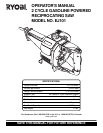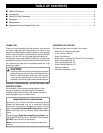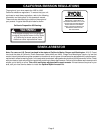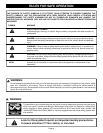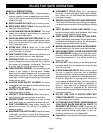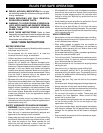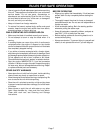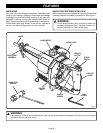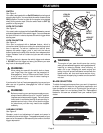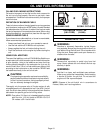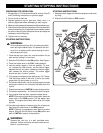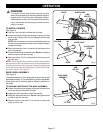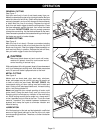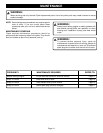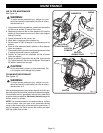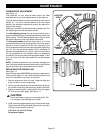
Page 5
READ ALL INSTRUCTIONS
■ KNOW YOUR POWER TOOL - Read operator's
manual carefully. Learn its applications and limita-
tions as well as the specific potential hazards re-
lated to this tool.
■ KEEP GUARDS IN PLACE and in working order.
■ KEEP WORK AREA CLEAN. Cluttered areas and
benches invite accidents.
■ AVOID DANGEROUS ENVIRONMENT. Don't use
power tool in damp or wet locations or expose to
rain. Keep work area well lit.
■ KEEP CHILDREN AND VISITORS AWAY. All visi-
tors should wear safety glasses and be kept a safe
distance from work area. Do not let visitors contact
tool or extension cord.
■ STORE IDLE TOOLS. When not in use, tools
should be stored in a dry, high or locked-up place -
out of the reach of children.
■ DON'T FORCE TOOL. It will do the job better and
safer at the rate for which it was designed.
■ USE RIGHT TOOL. Don't force small tool or attach-
ment to do the job of a heavy duty tool. Don't use tool
for purpose not intended - for example - Don't use
a circular saw for cutting tree limbs or logs.
■ WEAR PROPER APPAREL. No loose clothing or
jewelry to get caught in moving parts. Rubber
gloves and nonskid footwear are recommended
when working outdoors. Also, wear protective hair
covering to contain long hair and keep it from being
drawn into air vents.
■ ALWAYS WEAR SAFETY GLASSES. Everyday
eyeglasses have only impact-resistant lenses; they
are NOT safety glasses.
■ PROTECT YOUR LUNGS. Wear a face or dust
mask if operation is dusty.
■ PROTECT YOUR HEARING. Wear hearing pro-
tection during extended periods of operation.
■ SECURE WORK. Use clamps or a vise to hold
work. Both hands are needed to operate the tool.
■ DON'T OVERREACH. Keep proper footing and
balance at all times. Do not use on a ladder or
unstable support.
■ MAINTAIN TOOLS WITH CARE. Keep tools sharp
at all times, and clean for best and safest perfor-
mance. Follow instructions for lubricating and chang-
ing accessories.
■ DISCONNECT TOOLS. When not in use, before
servicing, or when changing attachments, blades,
bits, cutters, etc., all tools should be disconnected
from power supply.
■ REMOVE ADJUSTING KEYS AND WRENCHES.
Form habit of checking to see that keys and adjust-
ing wrenches are removed from tool before turning
it on.
■ KEEP BLADES CLEAN AND SHARP. Sharp
blades minimize stalling and kickback. Also, keep
blades properly tightened at all times.
■ KEEP HANDS AWAY FROM CUTTING AREA.
Keep hands away from blades. Do not reach under-
neath work while blade is cutting. Do not attempt to
remove material while blade is cutting.
■ NEVER USE IN AN EXPLOSIVE ATMOSPHERE.
Normal sparking of the motor could ignite fumes.
■ KEEP HANDLES DRY, CLEAN, AND FREE FROM
OIL AND GREASE. Always use a clean cloth when
cleaning. Never use brake fluids, gasoline, petro-
leum-based products or any strong solvents to
clean your tool.
■ STAY ALERT. Watch what you are doing and use
common sense. Do not operate tool when you are
tired. Do not rush.
■ CHECK DAMAGED PARTS. Before further use of
the tool, a guard or other part that is damaged
should be carefully checked to determine that it will
operate properly and perform its intended function.
Check for alignment of moving parts, binding of
moving parts, breakage of parts, mounting, and any
other conditions that may affect its operation. A
guard or other part that is damaged should be
properly repaired or replaced by an authorized
service center unless indicated elsewhere in this
instruction manual.
■ DO NOT USE TOOL IF SWITCH DOES NOT
TURN IT ON AND OFF. Have switches replaced by
an authorized service center.
■ CUTTING INTO ELECTRICAL WIRING IN WALLS
CAN CAUSE BLADE AND METAL PARTS TO
BECOME ELECTRICALLY LIVE. Grasp only the
handle(s) provided on the tool and be sure that
hidden electrical wiring, water pipes, or any me-
chanical hazards are not in blade path.
■ Inspect for and remove all nails from lumber before
cutting.
RULES FOR SAFE OPERATION



